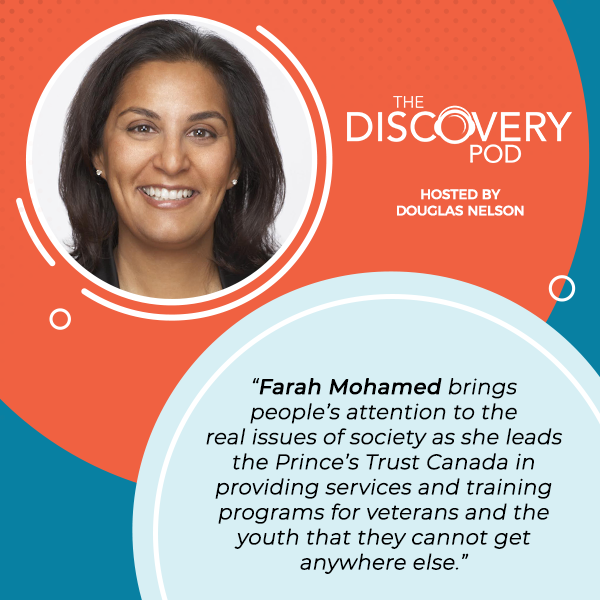
In anticipation of the Coronation of King Charles III, Douglas Nelson sits down with Farah Mohamed, CEO of the Prince’s Trust Canada. She talks about their development programs for veterans leaving active service and equity-deserving youth looking for employment. Farah explains how their work investing in these amazing people helps them pursue promising opportunities and serve society in the most fulfilling way. She also discusses how leaders should approach the war for talent and why she prefers the term social profit over not-for-profit.
—
Listen to the podcast here
Prince’s Trust Canada With CEO Farah Mohamed
Welcome to the show. In this episode, we have Farah Mohamed. Farah is the CEO of Prince’s Trust Canada. She’s going to talk about the Coronation. She is going to talk about the role of Prince’s Trust Canada in the development of exceptional programs for veterans leaving active service as well as equity-deserving youth who are seeking employment opportunities.
She’s got a unique take on the role of our sector and how we talk about our sector. A hint for those of you who are reading, she is a big believer in using social profit as opposed to not-for-profit to describe the great work that we do across this country. Farah shares her insights as a leader, what we need for the sector, and what she is optimistic about. You won’t want to miss this conversation with Farah Mohamed. Please enjoy.
—
Welcome, Farah.
Thank you. I’m thrilled to be here.
This is a very important conversation. It is a very important time in Canada as we get a new monarch. What better way to have that conversation than to start with the CEO of Prince’s Trust Canada? We’re all going to be watching the Coronation coming up and digging into what that means for us here in Canada. Maybe you could start us off by talking a little bit about what the Prince’s Trust in Canada is and the services that you provide because it’s going to surprise some of our readers.
Thanks very much. I like to refer to Prince’s Trust Canada as the best-kept secret in the country. It’s not the best-kept. We need to make sure that people know about this organization. This is an organization that was born of the vision of His Majesty King Charles. Long ago, he started talking about investing in young people around sustainability, community engagement, and using your time and your talent for good. Prince’s Trust Canada has taken that to heart. We have two audiences we serve. First, we serve veterans who are coming out of service. These are men and women who have incredible talents. They need to figure out how to use those talents in a world and life after service in the Military. It also includes their families.
The other group that we serve, and if people look at my past, they’ll say, “That makes sense if you went there,” is investing in young people. This is an organization that takes His Majesty’s commitment to young people seriously by saying, “How can we have young people reach their full potential through our partnerships and our programs and ensure that it’s not about what dreams they want to pursue? How can we tactically, tangibly set them up for success?” We have a number of different programs that expose them to skills, careers, and job placement.
I hope we’ll get into this a little bit later, but we’re going to be announcing a brand-new program. It is a very different program from what we’ve done before. It will be a game-changer. It is made in Canada and made for Canadian youth. It will move down their journey in terms of securing employment not just for now but for the future.
Let’s not make them wait. Let’s talk about that program. What is that program?
We did a lot of work and a lot of research by speaking to youth, partners, employers, and collaborators. What we found was that coming out of COVID, young people are struggling on a few fronts. One is finding the opportunities they want versus the opportunities there. Largely, that’s about how most employers require young people to have three years of employment before they’ll employ them. They’ve spent a lot of money on education. They’ve got this great education. They have a dream and a desire, but they don’t know where to put all that.
We’ve also got young people who are not in education. They’re not in employment, and they’re not in training. We refer to them as NEET. We’ve got young people who are equity-deserving. We’ve taken all that and said, “How do we make sure that you square the circle on having exposure to what you need to survive, succeed, and thrive in three different sectors? How do we make sure that you are invested in a way that you’re going to invest in yourself?”
I’ll tell you. We’re going to do a one-year program. It will be one month of onboarding. It’s all the skills you need to have to work in the private sector, social profit sector, and public sector. Young people probably want to pursue jobs in government, but they don’t know how. They might want to get a job in social profit, but they’re not sure if that’s the right fit. It’s the same for the private sector.
We lead into 9 months, where they’re doing a 3-month placement in each of the different sectors. The month on the way out, they’re doing outboarding. We’re saying, “Let’s look at your CV. Let’s look at your digital profile. Let’s make sure you’re going in for interviews. Let’s get you a job.” This is a journey. These young people will be paid. We’re not asking people to give up time and not be paid for their time. These are jobs.
We’re building this out. We’re in a situation where we’re taking the time to get it right. That means working with young people to figure out what they want and working with employers to figure out what jobs can we get them. The idea is you go into this program and walk out with skills and experience in a similar role. Let’s say you want to be in sustainable marketing. It’s a perfect example. You would spend three months, maybe at the Toronto Zoo. Maybe the next three months are in the private sector that’s working on energy. Maybe the last three months is the Department of Climate Change, Department of Natural Resources, or whatever. It is to that young person knows what that job is in three different sectors.
How do you beat that kind of experience? You’re setting this young person up for success. We’re working on that. We will launch that program in June of 2024. We’re going to build the best program for young people this country has ever seen. We’re going to do it in partnership. We’re going to do it with the government. We’re going to do it with the private sector. We’re going to do it with social profits like us, who are doubling down on young people.
How did you identify the need for a program like this? When you describe it, it sounds like a perfect solution to a well-articulated problem. Often, what I find in our sector is if the solutions were easy, they would’ve already been found. It can sometimes be a journey for organizations to articulate the problem they’re trying to solve and then come up with a solution. Your solution sounds wonderful. It sounds like exactly what we need. I love the confidence. Give our audience a taste of the process you and your colleagues went through to define the problem to develop this solution.
The first thing you do is to listen to the people you’re trying to serve. I’m far from being 18 to 30. I know from working with youth and my team knows what is happening with youth, but you have to listen to youth. You have to talk to them. You have to understand what it is that they’re looking for and build from there.
To provide the right support for the youth, one must talk to them and listen to what they think or are going through. Click To TweetYou also, at the same time, have to listen to your partners because they’re seeing things you may not see. You’ve then got to figure out, “What is the research telling us? Where is the future of jobs? Where are some of the challenges?” You take all that in and say, “What’s missing?” What’s missing is a journey. We’ll continue to do some of this with 90 minutes here, 1 day here, or 3 days here. That works, but it doesn’t work for everyone.
I’ll back this up. I’ve been working with youth for quite some time. I can’t tell you how many times I’ve heard, “I don’t have enough experience. I don’t know how social profit works. Why would I consider a job in government?” How do we tackle that? We put them in sitching. You put them in a situation where they can learn, listen, network, and maybe discover that they want to be in the X sector versus where they thought they wanted to be. It’s built for a purpose.
First of all, it’s built with young people in mind. I’ll tell you that we’re looking at a year. It may be after a pilot, we do nine months. Maybe we do six months. We need to try something that’s bold. We need to be ambitious for young people. We need to take some calculated risks. We have to have the courage to do something different. That’s what this is. It is the courage to do something different.
I like that phrase you used, which is purpose-built, because it’s not, “Here’s the program. Fit yourself into it.” It sounds like there is an opportunity for each individual participant to customize their journey through it to some extent.
I want to jump on that, though. One of the things we do with young people is put them in a program and then forget that these are equity-deserving youth who are facing challenges. We need to support them through the challenge. We can’t say, “Go through this program. Good luck.” We are contemplating how you have coaches along the way. It’s not mentors or bosses but coaches who can help them navigate some of the challenges that they’re facing so we can retain them.
We did a mitigation plan and said, “What are some of the risks?” Some of the risks are whether we are going to find enough employers. I hope if Canadian employers are serious about their pipeline for employees, they’ll take a look at this program and go, “We’re not just going to put money in that and put our logo on it, but we’re going to create space in our organization for young people.” Not everyone needs to have a Master’s. Not everyone needs to have an undergraduate degree. There can be other ways that you can put people in there and they’re perfect. They will soar if you give them a shot. That’s what we’re looking for.

Prince’s Trust Canada: Not everyone has a degree. Despite this, there are many other ways for people to get the best job for them where they can soar if given a chance.
Is there an element of cohort learning that’s baked into the program so that the shared journey and shared experience can support the students as they go through it?
You got it. We’re contemplating all types of things, like, “Do we get them to work on something together as a cohort?” How many programs have you, yourself, been through where you’ve made some incredible connections that are still part of who you are? That cannot be undervalued. We’re going to do this nationally at some point. Think about building a national network like that. That’s what we need young people to have. It is their own network. People that they would maybe not otherwise have met, they met them through this program. When we do this right and when we do this with programs, we’ll have proof of concept. We’ll be the program where people say, “You went through Prince’s Trust Canada’s program? We’ll hire you.” That’s what we want for these young people.
One thing we’ve learned through our work here at the Discovery Group is when you’re working with adult learners, whether it’s 18-year-olds, 29-year-olds, or those of us that are significantly north of that, the learning is not always best when it is someone imparting knowledge. In fact, it works so much better, lasts longer, the learning is richer, and the experience is more meaningful when it is that cohort learning. It works so much better when there is that variety of hard experiences in an environment. It sounds like you’ve nailed it here.
Thanks. It might be harder and more ambitious, but it’s worth doing. The point is not everything’s working. There are some amazing programs out there that are doing great things. We don’t want to discount those, but we know that something needs to be done that’s different.
We jumped into that because you were so excited. You were spilling over. This episode will come out right before the Coronation. Most of us are going to be witnessing an event that occurs once or maybe twice in a lifetime. If Charles lives as long as his mom, maybe we’ll never see it again. Can you show why this moment is so important and the influence it has here in Canada, specifically on Prince’s Trust Canada? Do you have to change your name?
Let me tackle all that other stuff and I’ll come back around that. There are very few times in life when you see a global moment that we can all experience together. The whole world is watching this. You’ll remember where you were on the day of the Coronation. I truly believe that. It’s one of those moments in history that the whole world is gathered around. You may be a Commonwealth country or you may not. Does it matter? This is an important time for the world. That’s number one. There are very few things that the entire world can rally around. That’s a pretty amazing opportunity.
What does it mean for Prince’s Trust Canada? We are very fortunate in that His Majesty will continue to be our president. That’s important because when you become the king, you are the patron and the president of many different organizations. You have to make some tough decisions. It’s humbling, but it’s also amazing to hear that he wants to continue with the Prince’s Trusts globally. There’s Australia and New Zealand. There’s the US. There’s Canada International and the UK. There are six of us. There are six entities. That’s a pretty big network of organizations that are working toward a common goal. To have him continue to be our president is pretty awesome for us. That’s the first thing.

Prince’s Trust Canada: King Charles wants to continue the Prince’s Trust in all six entities and remain serving as its president.
How will this affect us? It bolstered us. It’s pretty incredible to be the flagship charity of His Majesty in Canada. We need to use that to our advantage. We are very optimistic about what that does in terms of people learning about us. They’re not just learning that we exist, but what we do, who we serve, how we do it, and how we can be part of it. That will be a game-changer for us. That’s what we’re working toward.
In terms of names, we are Prince’s Trust Canada until I’m told otherwise. It is a fantastic brand. At the end of the day, for me, it’s about our participants and our programming. It’s very much about our partners, and it is about our president. At the end of the day, if those 4 or 5 things line up, that’s the perfect storm. We have all of those ingredients regardless of what we’re called.
When you tell people about your work at Prince’s Trust Canada, how do people phrase the question that asks you, “What exactly is that?” or, “What do you do?” How do you answer that in short form?
I usually say we’re in the business of investing in individuals. Whether that’s a veteran or a young person, we have a variety of programs that invest in your skills building, your employment, and your entrepreneurship. That’s what we’re in the business of doing. They’re like, “What does that mean?” I get to tell them about the boot camps that we have for veterans, the workshops we have for veterans or a Buy Veteran campaign. It is where you can go on a website and buy services and goods from veterans.
I tell them about the programs that we have where newcomers or equity-deserving youth go into a three-day program with a partner like Marriott or Weston. All of a sudden, at the end of that, after hard work and planning, they end up with a job. That’s what I tell them because it’s proof of concept. Nothing is more convincing than proof of concept.
I can talk a good game about programs. I can tell you a whole bunch of statistics. The most important part is that I can speak to individuals who’ve gone through our programming. They’ve gotten a job or have started their own business and have decided to go back to school because of something they learned through our programming. That, to me, is what we’re in the business of doing.
That dual mandate that you have with those two groups that you’ve identified, which are equity-serving youth and veterans transitioning out of active service, are there common challenges in those groups that you see them both struggling with? How do you try to bring those two together?
We don’t bring them together per se, but we do have learnings from one to the other. For example, we have a very robust program of mentorship in the veteran program. We are trying to understand what’s working there that we can impart into our new programming for this year-long program. There are similar challenges. If you think about people going through transition, there are some similar challenges. They’re like, “What am I going to do? Where am I going to do it? What are some of the resources I need? What if I want to work for myself?” These are things that it doesn’t matter if you’re a veteran coming out of service or a young person trying to figure out their path. There are some commonalities.
There are other commonalities that we then rely on partners to help us navigate for the people who go through our programs. Those are mental health issues, housing challenges, or relationships. We are not going to be the experts in those, but we can be a conduit for people to get support. That’s an important role for us to play. It’s to build partnerships around our programs so that if somebody comes through the door, they get to stay in the room because we are able to connect the dots with other partners.

Prince’s Trust Canada: The Prince’s Trust Canada is a conduit for people to get support. They build partnerships around their programs. If somebody comes through their door, they get to stay in the room.
There are lots of differences between the two groups. It boils down to people looking for opportunity and looking at how they maximize their talent and what they want out of their life. While they’re on different spectrums, there is magic in how at the end of the day, it’s about people who are pursuing and wanting to have a good life. They want to have what you and I want, which is to be happy in our jobs and in our lives and to feel like we’re giving back.
One of the things I’ll say is we have had people go through our programs who do give back. They come back and figure out how they pay it forward. That’s an important part. In the program that I spoke to you about, our new program, we want to figure out alumni. How does that alumni then help others who are going to go through it? This is something that we have built a community of incredibly thoughtful, kind, and generous veterans. The other similarity is they both need community. We’re building community. They are extraordinary individuals who are going on their own paths, but there are some similarities between the two.
There is a real elegance to the way you talk about the role of Prince’s Trust to convene around important issues, veterans, and access to the labor force for equity-deserving youth. You’re bringing people’s attention to the issue and providing services and training programs for those groups as well as connecting them to services that you don’t provide. Since you’re able to convene and focus a spotlight on these issues, you’re able to connect them to services that they can’t get in other places.
It’s a unique place or a unique niche in the social profit sector. It sounds like you’ve been thoughtful in the space that you occupy and why. I’m sure it’s a compelling value proposition for funders and partners. I’m curious about what it means for your ability to attract and retain the team to execute this. One of the things we’re hearing across the spectrum of social profit organizations across Canada is that some are calling it the war on talent or the war for talent. What are you observing? What do you think organizations need to do differently to recruit and retain the best talent?
I’m observing what you’ve called it. I do think it’s a war for talent. It’s particularly hard in our sector because there are limitations on compensation, but there are other things we can do. I’m super optimistic when it comes to the war on talent because we compete on impact, values, and passion. That doesn’t say you don’t get that in the public sector or the private sector, but that is our ace. If you’re in the social profit sector, that’s your ace. That’s what you’re putting out there.
You want to be fair in compensation. You want to be fair in benefits. You want to make sure that people have the proper working conditions where they have psychological safety and the ability to advance to be part of something that’s inclusive. We’ve come out of some of the worst years of our lives where we’ve been struggling and we’ve had to pivot. There are two options. We can go backward or we can go forward. I choose to go forward.
There are realities. People do not want to work in an office all the time. What are the things we’re facing? It’s the ones that I’ve counted, which are the compensation and all the other things. If employers aren’t willing to be accommodating to people with needs that have risen to the top because of COVID, you’re going to lose them. That’s it. What do you need to do? You need to make sure that you are accommodating. I don’t mean accommodating, like, “I have to do that.” If they’re happy and they feel like everything else is in line for them, they are going to be happier at their work. They’re going to be more cooperative. They’re going to be more collaborative. They’re going to give their all.
If employees are happy and feel like everything else is in line for them, they will be more cooperative and collaborative. Click To TweetRemove that irritant. Who cares if somebody comes in at 10:00 AM and leaves at 4:00 PM? If they’re getting their job done, who cares? It shouldn’t matter. If you’re going to hire someone, trust them. That’s the other thing. I don’t need to have people on the computer to see if their dot is red, green, or yellow. I don’t care. You have a job to do. I trust you to get it done. If you don’t get it done and it’s habitual, we got a problem. You got to change your mindset.
This whole coming in at 9:00 PM and leaving at 5:00 PM is BS. Time has come and gone. What I’m looking for in my team are people who are going to bring their A-game. They want to be high-performers for the people that we serve. They want to be collaborative. They’re curious. They’re going to say, “How do I make this better?” It’s about looking for different personalities.
We’ve got an office. It’s not occupied all the time. We have a minimum of two days that you have to be in the office. You pick those days. You do it with your team. Do I feel a little sad and lonely when there is nobody in there, I don’t see anyone in there, or there are two other people? It’s a missed opportunity. I still believe that collaboration comes from convening. I still believe that you build relationships with your coworkers in different ways if you’re sitting at a desk beside them or in the kitchen versus not being there.
I’m being long-winded, but employers have to shift the way that they recruit, where they recruit, and who they’re recruiting. They have to shift what they mean by “in the office.” You can be at home sitting in your pajamas, writing the best speech of your life, or you can be sitting in your office with a suit on or something uncomfortable and writing something mediocre. Which would you prefer?
I don’t know that anybody wears a suit anymore.
I was doing a speech and I put a suit jacket on. It was about authentic leadership. I got up to the mic and said, “I’m being super inauthentic. This suit would’ve felt like a second skin twenty years ago. Now, it feels like a 100-pound weight.” I took the jacket off and the place went crazy. It didn’t go crazy because I didn’t have anything else underneath. I had another top underneath.
My point is that the world has changed and we have to change with it. I would also add to it that I’m not used to having people come for 6 months or 1 year. I want my team to stay with me. I want them to grow with me. I want them to challenge me, and I want to challenge them. That means you need to put the time in. We need to find ways to do that.
This is the privilege of getting to work with so many organizations across the country. I had a conversation with folks at one place in a different province. They said, “It’s pretty strict. We have to be in the office one day a week. We try for Wednesdays, but that doesn’t work for everybody. It’s strict, and people don’t like that.”
We talked to other organizations where they’re like, “We’re back five days a week because we believe in teamwork. We’ll be better off acting as a team. We’re all in here acting as a team.” In the individuals that we interacted with, there was no complaint about that at all. That was the way they worked. It is this entire rainbow spectrum across the social profit sectors, as I’m sure across lots of sectors. There is no one-size-fits-all. There is no one suit jacket that fits perfectly for everyone.
That’s true. I’m glad that you said that though. I loved going into an office, and I see a lot of people on my team who don’t want to. We went from 1 day a week to 2 days a week. People are a little worried that I’m going to go to 3 or 4. I wouldn’t do that at the risk of leaving talent. The Farah many years ago would be like, “Deal with it.” That Farah has grown up. This is reality. Flexibility is key to retaining your talent. If you’re not willing to be a flexible leader, then you’re probably going to be sitting in your office by yourself. That is the outcome of somebody who’s not flexible.
Flexibility is key to retaining your talent. If you're not willing to be a flexible leader, you will probably sit in your office by yourself. Click To TweetLet me ask you this. One of the challenges that I hear a lot when I’m speaking to other leaders isn’t what they view as important. Most or many of the leaders in our sector recognize the need to meet their teams where they are. It’s an important part of retention, team building, and team effectiveness. They’re like, “We’re getting the work done. Why would we make people upset?”
Where are the challenges coming in? I’ve heard from a number of CEOs that it is explaining it to the board and their board members. They’re like, “Nobody’s doing work if they’re not in the office,” which is not the contemporary way of thinking about work in 2023. The tension between management and the board around those policies is very real for some CEOs. What advice would you give to CEOs getting that kind of pressure from her or his board?
First of all, I’ll give you a reflection of my board. I have a very diverse board. They come from different walks of life. They are living in different parts of the country. They are incredibly savvy at dealing with reality. I haven’t had any pushback because they know this is reality. They’re dealing with it in their own lives. I don’t think they’re going to impose something on Prince’s Trust Canada that they’re dealing with in their own work instances.
My advice would be you’ve got to be straight up with your board. I don’t think you should sugarcoat things. It’s up to you as the CEO to be super transparent. You’ve got to mitigate risks. I believe in noses in, fingers out. A board has to listen to its management when they’re saying, “I am going to lose talent if we push this too hard.”

Prince’s Trust Canada: CEOs must be transparent with their board. Do not sugarcoat things and always aim to mitigate risks.
There are also consequences of not pushing hard enough. If you believe that great things will come from having your team in your office and that’s your leadership style, and that’s what you need to get an organization on track or to recalibrate, or whatever the case may be, you also have to be straight up with your team. You have to say, “I am telling you as a leader that I need you to trust me.” You lay it all out. You’ve got to be transparent on both sides. If you’re not willing to do that, you’d get caught in the middle. That’s how you get a problem with your board. Anything lacking transparency will kill you.
That’s a good pivot point to the other topic I want to bring up around the sector. I smiled as you said social profits sprinkled in through our conversation. At the Discovery group, we’ve made a deliberate effort to talk about the work of our sector as the social profit sector as a positive definition of the work that we do.
I often think that the term not-for-profit is like defining ourselves as Canadians by saying, “We’re not Americans.” It is accurate but not sufficient. We want to emphasize the positive abundance of our sector. I know you make that distinction, too. How should we be talking about ourselves, and why should we be using the term social profit?
I don’t describe myself as not Brown. I don’t say I’m not tall. I don’t say I’m not a man. Why in the world would I describe my work as a not-for-profit? That’s crazy. If you don’t know me, I’m a Brown woman. I’m 5’1” and a quarter. I’m female. I don’t describe myself as what I’m not. I refuse to describe what I do as something that’s not. If people want to describe themselves as a not-for-profit, they should keep the following stats in their mind. 2.4 million Canadians work in our sector. That’s ridiculous. We contribute 8.3% of GDP. That’s about $192 billion.
That’s quite an industry.
There are 13 million volunteers, close to $2 billion. Is that something that’s not counted? I got up in front of an audience. Part of my life has been doing speaking gigs. I love it because you feed off the audience. You can say stuff. If it’s not recording, you can say all kinds of stuff. I once did a speech and said what I said without the stats. My agent was called afterward and said, “That was pretty upsetting for some people to hear that she’s dissing a not-for-profit.” I was not dissing the not-for-profit. In fact, I was doing the opposite. I’m weary that people are not listening to taking a hold of this and saying, “This is a billions-of-dollars industry.” We don’t talk about ourselves like that. We’re a sector.
It’s bigger than forestry. It’s bigger than mining.
Maybe this is something we could do together. I want to have people to stop using negative language. We have changed it in so many places in so many different ways. Yet, we decide that we’re not going to do it in this sector. It’s crap. It’s enough.
I’m far from the perfect messenger around this point of the argument. It is fair to say that the not-for-profit, the not recognized part of this is highly gendered with the idea that the work of service and community support in our society has traditionally been done by women.
Women are close to 80% of the workforce when it comes to the social profit sector. That’s a good question. Do we discount it because there is a certain gender doing it well?
That is what’s happening.
You’re right. I don’t have any evidence. I don’t have anything to back that up. Shame on us. I’d like to see how Canada or any other country survives without a robust social profit. Let’s pull it out and see what happens. Let’s fold it up and go home.
Let’s use that as a thought experiment because it would be bad if that happened. The other part about the negative definition is that scarcity dominates our sector. This feeling of insufficient or never enough resources and how we are always coming from behind is one of the reasons why I was so interested in how you defined the problem for your new youth program. You were not using scarcity language at all. You were using abundant language.
When we are defining every opportunity as a challenge and every potential as a strength or a weakness, it does a disservice to the people who do the work. It does a disservice to the people they serve. It does a disservice to the donors who support the organizations. The negative cast of not-for-profit or non-profit has a bit of a 10-pound or 20-pound penalty on our sector. I’m with you. Let’s take it off. I don’t know who we call or who we write a letter to.
Let’s call everyone. All leaders need to change their language. The media needs to change its language. People who work in the sector have to say, “I work in the social profit,” etc. I will say one thing. To everyone who thinks that we don’t have stringent rules in place or that we don’t have shareholders and stakeholders, you go try to get a charitable number from CRA and tell me if that’s not tough. There are a lot of things you have to do. You have to do it every single year, and you should be.
Accountability is at an all-time high for social profit. Yet, we think about accountability in terms of a P&L or a shareholders’ meeting. We think about that in terms of the private sector. That exists. It’s our shareholders, stakeholders, donors, participants, partners, and the government. They’re everyday Canadians who benefit from the work that we do full-stop.
I’m hesitant to continue after that, but in the spirit of using abundant language and seeing the potential and the opportunity, you talked about the hope associated with the Coronation coming. What do you see as the biggest opportunities for our social profit sector?
There are many. The number one opportunity for all of us, if we’re thinking strategically, is to figure out where we can partner. There’s a lot of duplication in the system, which is why our program is inviting a sense of partnership. That’s one. The opportunities are for strategic partnerships. It’s not just partnerships but strategic ones where everybody does win. We’re not shy about that.
Somehow, we’re shy to say, “This is an advantage,” or, “We’re going to double down on this because of X, Y, and Z.” It’s all very positive. I’m not the poor cousin. I’m far from it. That’s number one. It’s the partnership. We’ve got to invigorate, invite, and be inspirational for our youth. This is perhaps a generation that they’re so motivated by values, impact, and how they make a difference. We have to figure out how we capitalize on that. That’s number two.
Do you want to talk about the war on talent? We have to be willing to compete on the values that they hold dear. There’s never been a better time to engage young people because they do want to make a difference. That’s number two.

Prince’s Trust Canada: The only way to fight in the war on talent is to be willing to compete on the values people hold dear.
Number three, we got to shake off any kind of, “Woe is me. I’m the poor cousin,” and coming from a position of begging. That is so old-school. This is a sector that if we all took a collective sigh and said, “What kind of difference do we make?” we would present ourselves differently. I do that with this charitable organization. I’ve done that with previous ones. I sit at the table with many who do that. Before I did this show, I was speaking to the leadership of YSM or Yonge Street Mission. They are so ambitious for the people they serve. They do it without hesitation. We need more of that.
You started our conversation off by talking about delivering the best program we’ve ever seen for equity-deserving youth seeking employment. I love the ambition. I love the framing. I love your vision for where this sector can go. Thank you so much for being on the show.
Thanks. I loved our conversation. Know, heads-up, I’m going to come and knock on your door and you’ll be interviewing one of the people who go through our program before too long.
I can’t wait to do it.
Important Link
About Farah Mohamed
 Farah is a tri-sector executive leader with more than 25 years of experience creating and leading organizations and social impact initiatives at a national and international level. She has worked alongside politicians, entrepreneurs, business leaders, philanthropists and change-makers, including Nobel Laureate Malala Yousafzai.
Farah is a tri-sector executive leader with more than 25 years of experience creating and leading organizations and social impact initiatives at a national and international level. She has worked alongside politicians, entrepreneurs, business leaders, philanthropists and change-makers, including Nobel Laureate Malala Yousafzai.
During her time in Canadian politics, Farah served as the Chief of Staff to the Honourable Paddy Torsney and then as Director of Communications for Deputy Prime Minister Anne McLellan.
Farah is the Founder of Fora (formerly G(irls)20) – the first organization to lobby G20 Leaders to consider female labour force participation as an economic advantage.
She came to Canada as a refugee from Uganda at the age of two. Today she serves as the CEO of Prince’s Trust Canada, His Majesty The King’s flagship charity in Canada.


